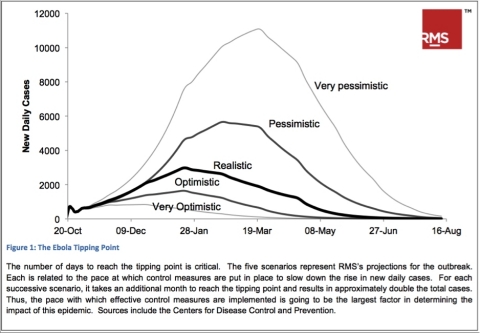The Ebola virus disease outbreak in West Africa has the potential to be the most deadly infectious disease event since the 1918 flu pandemic, according to a new report by catastrophic risk modeling firm RMS.
RMS said the current outbreak will continue to worsen while the deployment of resources is ramped up to meet the caseload. According to RMS modeling, until a tipping point is reached—where the number of new daily cases declines rather than increases—the total number of new cases roughly double each month.
RMS said it does not expect this outbreak of Ebola to become a significant mortality threat outside of West Africa.
“Controlling the spread of this Ebola outbreak is more a question of logistics than virology,” said Dominic Smith, pandemic risk expert and senior manager of Life Risks at RMS, in a statement. “The fight against the Ebola epidemic is a race against a moving target; more resources are required as the number of cases increases.”
RMS modeling suggests that, based on current response efforts, the tipping point will be reached in January 2015.
RMS modeling further reveals a 55 percent chance that by the end of November, at least 1,000 new cases of Ebola will develop daily, and as many as 1,400 per day in a worst-case scenario. There have been more than 9,000 cases reported in total to date.
Adding to the devastation of the Ebola outbreak, overwhelmed medical systems in West Africa have less resources to respond to other diseases and the mortality rate of malaria and yellow fever is on the rise, according to the report. Also, malaria deaths are likely to continue rising as the seasonal height of malaria transmission is reached next month.
RMS modeled the future paths of cases and deaths from the Ebola virus in Sierra Leone, Guinea and Liberia, which were combined with a probabilistic assessment of various international medical and military response scenarios to estimate the timing of the tipping point where cases are controlled such that the disease tapers off.
Tipping Point
If effective resources are deployed at a rate that outstrips the pace of increase in new cases, a tipping point can be reached where the number of new daily cases reaches a maximum, allowing response measures to kick in and prevent new infections at a rate that causes the epidemic to subside.
“The way to stop this outbreak is simple in principle and has been demonstrated in Nigeria and in specific cities in the affected region: reduce contacts with infected people by more than half,” said Smith. “The scale and pace of the international response will define how long it takes to reach the tipping point.”
The U.S. Centers for Disease Control and Prevention (CDC) estimates that, even in the absence of treatments and vaccines, the epidemic would be brought under control and eventually come to an end if approximately 70 to 75 percent of cases are in medical care or treatment units, or in environments where there is a reduced risk of disease transmission.
In a realistic scenario based on current response efforts, RMS analysis projects the tipping point will be reached at the end of January 2015, with the outbreak subsiding by June 2015.
Outside West Africa
RMS said it does not expect this outbreak of Ebola to become a significant mortality threat in other parts of the world. It is possible that it could spread to neighboring countries in West Africa. This risk can be reduced by appropriate screening of people leaving the impacted region and could be contained with rapid implementation of effective control measures.
In the situation where there are potentially 10,000 new cases per week in West Africa, there will be more cases exported into other countries. This is possible via two routes:
Foreign workers combating the spread of the virus are likely to be repatriated to their home countries. Currently the United States, United Kingdom, France and Cuba have delivered personnel in significant numbers. RMS does not consider this to be a probable source of escalation as such cases will be monitored and isolated by the public health systems already in place in those countries.
Infected people traveling to other regions unchecked could transmit Ebola outside of West Africa. However, the capability of most countries to trace contacts is higher than in Liberia and Sierra Leone, and stronger travel control measures could be implemented if case numbers exceeded a prudent limit.
RMS said it will be updating the model with new numbers every few weeks, projecting the course of the event in near real-time.
Source: RMS
California-based RMS models and software help financial institutions and public agencies evaluate and manage catastrophe risks throughout the world.





















 Uncertainty Keeps Prices Up; No Prior-Year Loss Development: Travelers
Uncertainty Keeps Prices Up; No Prior-Year Loss Development: Travelers  Survey: Majority of CA/FL Homeowners See Rise in Insurance Costs, Coverage Changes
Survey: Majority of CA/FL Homeowners See Rise in Insurance Costs, Coverage Changes  Triple-I: Insurance Economic Drivers Outperform Overall U.S. GDP
Triple-I: Insurance Economic Drivers Outperform Overall U.S. GDP  Travelers: Distracted Driving Incidents Continue to Rise
Travelers: Distracted Driving Incidents Continue to Rise 







